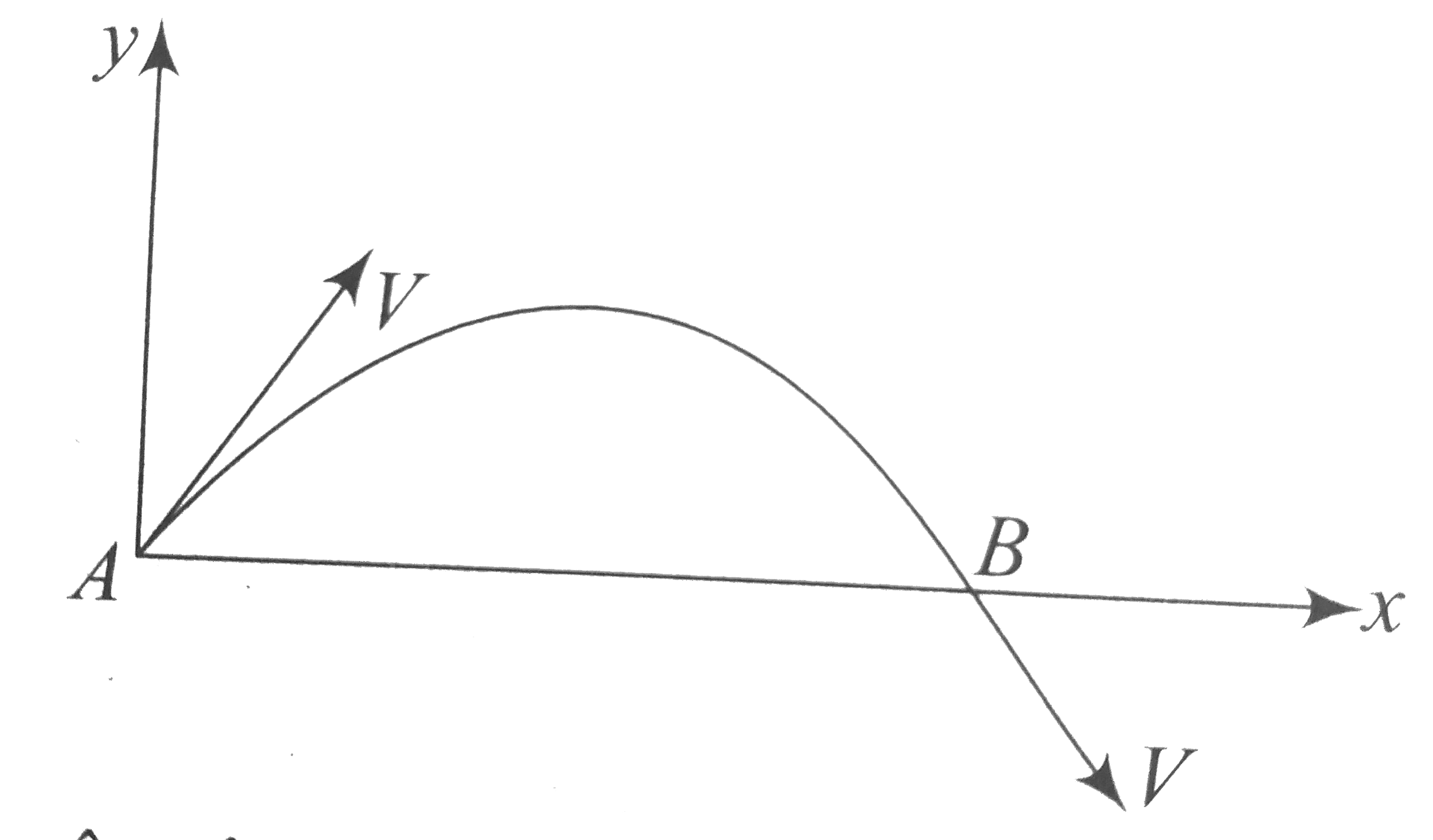What will be the equation for the path of a projectile if it is fired with initial velocity of (2ˆi+3ˆj). Here ˆuandˆj are unit vectors along X-axis and Y-axis (g=10ms−2).
The correct Answer is:4y=6x−5x2
To find the equation for the path of a projectile fired with an initial velocity of u=2^i+3^j, we will follow these steps:
Step 1: Identify the components of the initial velocity
The initial velocity vector can be broken down into its components:
- ux=2m/s (horizontal component)
- uy=3m/s (vertical component)
Step 2: Calculate the angle of projection
Using the components of the initial velocity, we can find the angle θ of projection using the tangent function:
tanθ=uyux=32
Step 3: Calculate the magnitude of the initial velocity
The magnitude of the initial velocity u can be calculated using the Pythagorean theorem:
u=√u2x+u2y=√22+32=√4+9=√13
Step 4: Write the equation of the trajectory
The general equation of the trajectory of a projectile is given by:
y=xtanθ−gx22u2cos2θ
Substituting g=10m/s2 and u=√13:
1. Calculate tanθ:
tanθ=32
2. Calculate cos2θ:
cos2θ=u2xu2=2213=413
Now substituting these values into the trajectory equation:
y=x(32)−10x22⋅13⋅413
This simplifies to:
y=32x−10x28=32x−54x2
Step 5: Rearranging the equation
To express the equation in a standard form, we can multiply through by 4 to eliminate the fraction:
4y=6x−5x2
Rearranging gives us:
5x2−6x+4y=0
Final Equation
Thus, the equation for the path of the projectile is:
4y=6x−5x2
---
The initial velocity vector can be broken down into its components:
- ux=2m/s (horizontal component)
- uy=3m/s (vertical component)
Using the components of the initial velocity, we can find the angle θ of projection using the tangent function:
tanθ=uyux=32
The magnitude of the initial velocity u can be calculated using the Pythagorean theorem:
u=√u2x+u2y=√22+32=√4+9=√13
The general equation of the trajectory of a projectile is given by:
y=xtanθ−gx22u2cos2θ
Substituting g=10m/s2 and u=√13:
1. Calculate tanθ:
tanθ=32
2. Calculate cos2θ:
cos2θ=u2xu2=2213=413
y=x(32)−10x22⋅13⋅413
This simplifies to:
y=32x−10x28=32x−54x2
To express the equation in a standard form, we can multiply through by 4 to eliminate the fraction:
4y=6x−5x2
Rearranging gives us:
5x2−6x+4y=0
Thus, the equation for the path of the projectile is:
4y=6x−5x2
Topper's Solved these Questions
- BOOK - MODERN PUBLICATIONCHAPTER - MOTION IN A PLANE EXERCISE - PRACTICE PROBLEMS (5)5videos
MOTION IN A PLANE
- BOOK - MODERN PUBLICATIONCHAPTER - MOTION IN A PLANE EXERCISE - PRACTICE PROBLEMS (6)1videos
MOTION IN A PLANE
- BOOK - MODERN PUBLICATIONCHAPTER - MOTION IN A PLANE EXERCISE - PRACTICE PROBLEMS (3)2videos
MOTION IN A PLANE
- BOOK - MODERN PUBLICATIONCHAPTER - MECHANICAL PROPERTIES OF FLUIDSEXERCISE - Chapter Practise Test16videos
MECHANICAL PROPERTIES OF FLUIDS
- BOOK - MODERN PUBLICATIONCHAPTER - MOTION IN A STRAIGHT LINE EXERCISE - CHAPTER PRACTICE TEST16videos
MOTION IN A STRAIGHT LINE
Similar Questions
A projectile is given an initial velocity of (ˆi+2ˆj)ms, where ˆi is along the ground and ˆj is along the vertical. If g=10ms−2, the equation of its trajectory is
View SolutionDetermine that vector which when added to the resultant of →P=2ˆi+7ˆj−10ˆk and →Q=ˆi+2ˆj+3ˆk gives a unit vector along X-axis.
View Solution
Knowledge Check
- Question 1 - Select One
The angle θ between the vector p=ˆi+ˆj+ˆk and unit vector along X-axis is
Acos−1(1√3)Bcos−1(1√2)Ccos−1(√32)Dcos−1(12) - Question 2 - Select One
A particle is projected with initial velocity of ˆi+2ˆj. The equation of trajectory is (takeg=10ms−2)
Ay=2x−15x2By=2x−25x2Cy=x−5x2Dy=2x−5x2 - Question 3 - Select One
If a=2ˆi+5ˆjandb=2ˆi−ˆj, then the unit vector along a+b will be
Aˆi−ˆj√2Bˆi+ˆjC√2(ˆi+ˆj)Dˆi+ˆj√2
Determine that vector which when added to the resultant of →P=2ˆi+7ˆj−10ˆk and →Q=ˆi+2ˆj+3ˆk gives a unit vector along X-axis.
View SolutionThe equation of the path of the projectiles is y=0.5x−0.04x2 .The initial speed of the projectile is? (g=10ms−2)
View SolutionA projectile is given an initial velocity of (ˆi+2ˆj) The Cartesian equation of its path is (g=10ms−1) ( Here , ˆi is the unit vector along horizontal and ˆj is unit vector vertically upwards)
View SolutionThe velocity of a projectile at the initial point A is (2ˆi+3ˆj)m/s. Its velocity (in m/s) at point B is
 View Solution
View SolutionThe velocity of a projectile at the initial point A is (2ˆi+3ˆj)ms−1. Its velocity (in ms−1) at point B is
 View Solution
View Solution

